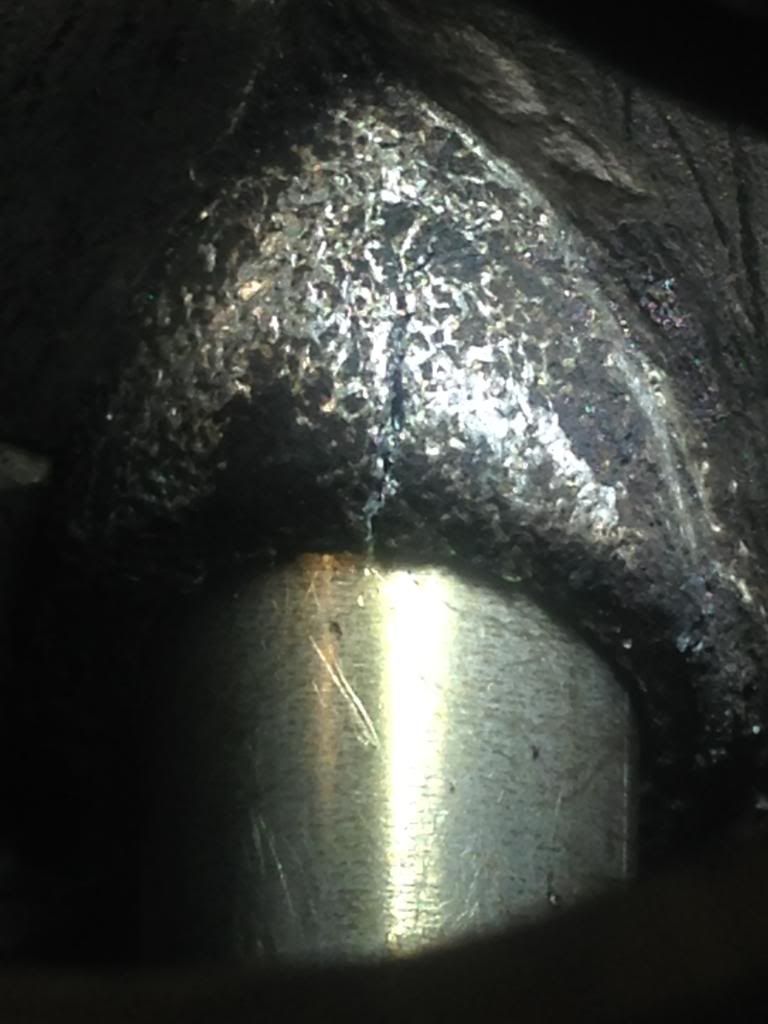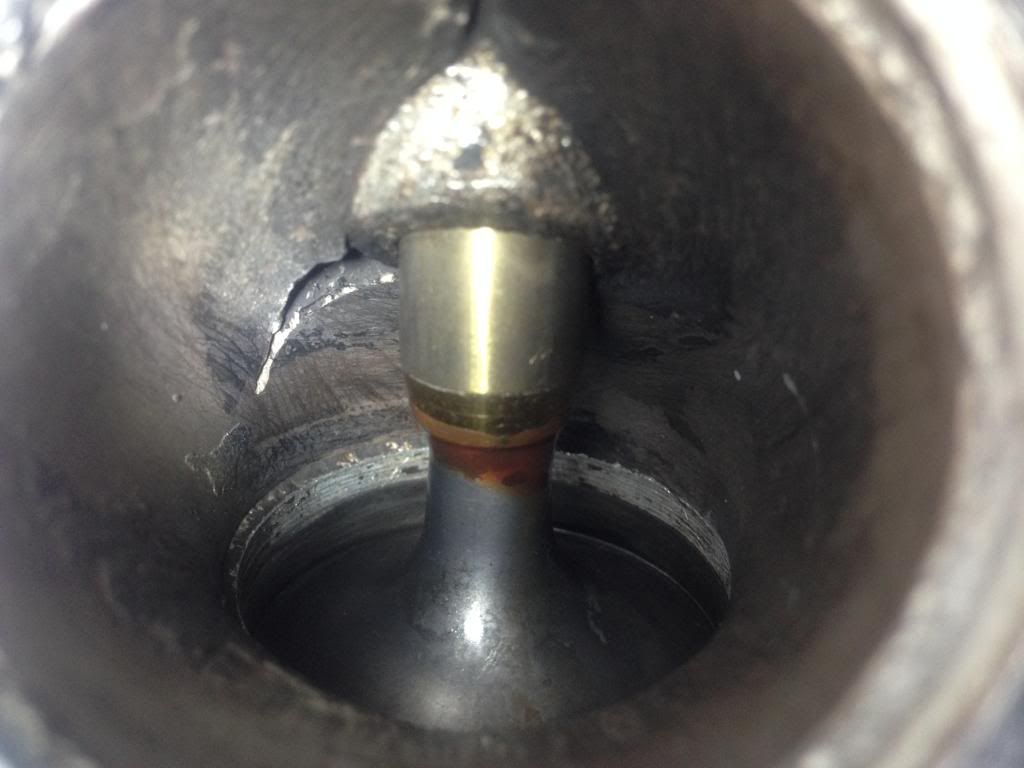 |
 |
 |
 |

|

|
|
|
|
|
|
Registered
Join Date: Apr 2002
Location: Cambridge, MA
Posts: 555
|
964 heads- valve guide boss crack
Hi folks,
Looks like there is a lot more traffic over here than at rennlist for engine build specifics. I'm doing a straight-forward top end on a late 1991 3.6L. Reasons to open it up were exhaust valve guide leaks and a gasket reseal. Anyway, I just took a close look at the heads that I had reconditioned and found a crack along the valve guide boss. Found this on two cylinders. Pic shows the worse one. The crack in the other head is very very slight:  What I've turned up on the web: - One fellow who ran an engine like this and a large chunk of the boss broke off. - Competition Engineer website lists "Repair crack in port at valve guide boss $215" as one of their services. - Supertec not concerned about it, they also grind off the whole boss when doing a race port. So options seem to be 1) Ignore and run as-is, 2) have it repaired/welded 3) an excuse for some fancy port work. I was also surprised to find the exhaust valve seat is not blended into the port at all. Porsche seemed to think that this wasn't important? I can see a good 1mm+ step on almost all of the heads. Is it worth spending the time to blend these into the rest of the port? The intake seats look great and are completely smooth to the rest of the port. You can see the step pretty clearly in the photo-  Appreciate any feedback. More details in the RL thread: I'm in the motor now - Rennlist Discussion Forums
__________________
1991 964 C4 Cabriolet - drop-top pylon destroyer |
||
|
|
|
|
Straight shooter
|
Cracks propagate. I would not run it as is. First step would be to break the head back down and Magnaflux to determine how far the crack has propagated. I would check all heads not just the ones which have visible cracks.
Depending on results I would either remove the boss and enclosed crack entirely (I would because I like hp) or weld repair if it has gone beyond the boss into the head. The weld repair is less attractive because you start the valve guide job all over again whereas you may save time with a port job with the existing guide in place should you have the option to remove the boss and whole crack. I would also blend the seat as you hint to. Good luck.
__________________
“Of the value traps, the most widespread and pernicious is value rigidity. This is an inability to revalue what one sees because of commitment to previous values. In motorcycle maintenance, you MUST rediscover what you do as you go. Rigid values makes this impossible.” ― Robert M. Pirsig, Zen and the Art of Motorcycle Maintenance: An Inquiry Into Values |
||
|
|
|
|
Registered
Join Date: Jun 2010
Location: Arizona
Posts: 2,034
|
I'm guessing whoever did the valve job just took a hammer to the valve guide and pounded away.
one way I learned to remove old guides is to get a drill bit a little smaller than the diameter of the guide and drill the guide out, but don't drill all the way through. Drill almost all the way through. After this is done, get a steel drift and insert into the drilled hole and then pound the guide out. If you're really worried about the crack, the only thing you can do is grind it out and put a radius on the edge. Or get a new head. |
||
|
|
|
|
Registered
Join Date: Jul 2001
Location: Portland Oregon
Posts: 7,007
|
Your guides were improperly installed and I've seen quite few of these over the years.
The head with small crack at the guide boss can be repaired, but the other head should be discarded since that will propagate to the seat. Although those can be welded, such cracks are tough to reliably repair and I would not use it.
__________________
Steve Weiner Rennsport Systems Portland Oregon (503) 244-0990 porsche@rennsportsystems.com www.rennsportsystems.com |
||
|
|
|
|
Registered
Join Date: Apr 2002
Location: Cambridge, MA
Posts: 555
|
Thanks for the feedback! Using as-is is definitely off of the table. Options, barring the horsepower fairy dropping off a set of 9m heads, appear to be: weld/repair existing, replace with a new/used head, or grind off the boss entirely as long as the crack isn't deeper into the casting. The latter option sounds easiest, if only to avoid another complete valve job.
What I'm wondering about now is what I can't see. If the new guides were pounded in so brutally, are there invisible problems lurking? Are there potential problems that magnaflux won't find? And then, is it safe to grind off the bosses with the guides still installed and how delicate of a process is that?
__________________
1991 964 C4 Cabriolet - drop-top pylon destroyer |
||
|
|
|
|
Registered
Join Date: Jul 2001
Location: Portland Oregon
Posts: 7,007
|
I would NOT grind on them at all. Have the one head properly repaired by removing the guide, prepping and welding the guide boss, then refinishing it by hand. The other head is junk so you'll need a good used one if you can find it.
The others may be OK, but only a VERY close inspection will tell you anything and I cannot offer constructive info without seeing them for myself.
__________________
Steve Weiner Rennsport Systems Portland Oregon (503) 244-0990 porsche@rennsportsystems.com www.rennsportsystems.com |
||
|
|
|

|
|
Straight shooter
|
If you do grind the boss/guide then you would need to de-bur and quick hone check for size. This would be a tradeoff of valve cooling for port flow. I would be more inclined to perform this on the intake side where cool air and fuel keep the valve temperature down rather than the exhaust side where you need all the guide contact you can gather for sufficient valve cooling. It is fairly common to see this on competition heads of many makes and HP levels. As I play with mostly turbo cars I don't normally mess with stock port profiles as there are other changes such as boost pressure/undercut valve head/camshaft that offer far greater gains for part cost/labor.
__________________
“Of the value traps, the most widespread and pernicious is value rigidity. This is an inability to revalue what one sees because of commitment to previous values. In motorcycle maintenance, you MUST rediscover what you do as you go. Rigid values makes this impossible.” ― Robert M. Pirsig, Zen and the Art of Motorcycle Maintenance: An Inquiry Into Values |
||
|
|
|
|
Registered
|
If you do choose to weld them...remember...remove the guides and weld the entire hole shut.
After the welding...you can bore the guide hole to size...and be reasonably sure that you have good contact with the head to guide fit (for heat transfer). But....I would go with Steve and Andrew...find a good head to replace it...probably will be cheaper in the long run. And in the future....the guides should be cleaned off on the port side before pushing them out. I use a tube-like tool to make the outside of the guides smaller before pushing. Bob
__________________
Bob Hutson |
||
|
|
|
|
Registered
Join Date: Apr 2002
Location: Cambridge, MA
Posts: 555
|
Alright, getting the message that grinding off the boss isn't a great idea. Though I'm curious why that is the case? The small amount the protrudes past the ceramic liner can't offer much for heat transfer? And I also wouldn't think that the boss adds much for valve guide structure?
Steve W- I'm not sure I understand what you mean by: the head with the crack on the boss can be repaired, but the other one needs replaced? The other photo shows cracks in the ceramic liner. According to Porsche TSB it isn't anything to worry about until a 1 square cm chunk of the liner is gone. Which is pretty substantial. These ceramic liner cracks don't look nearly as bad as photos that I've seen in other threads. Walt at Competition Engineering seems to get a unanimous thumbs-up. I'll give them a call Monday morning. I'm leaning toward just sending the whole lot to them to check and weld/repair. At least I know where my heads have been as opposed to a tracking down a good used set. Now what to do about the shop who originally did the work? Refund on the guide work they performed seems pretty obvious. I supplied them with guides and stem seals from Pelican, which aren't too expensive. Having CE repair and repeat the valve job is going to be much more than had the work been done right to begin with. Any ideas on an approach? Have the original shop pickup the tab that is over and above CE's normal valve job? Split the difference? One could argue that some of the blame is on me for not knowing how delicate guide replacement is on these heads and not using a Porsche shop to begin with.
__________________
1991 964 C4 Cabriolet - drop-top pylon destroyer |
||
|
|
|
|
Registered
|
Quote:
__________________
Magnus 911 Silver Targa -77, 3.2 -84 with custom ITBs and EFI. 911T Coupe -69, 3.6, G50, "RSR", track day. 924 -79 Rat Rod EFI/Turbo 375whp@1.85bar. 931 -79 under total restoration. |
||
|
|
|
|
Registered
Join Date: Jul 2001
Location: Portland Oregon
Posts: 7,007
|
Quote:
__________________
Steve Weiner Rennsport Systems Portland Oregon (503) 244-0990 porsche@rennsportsystems.com www.rennsportsystems.com |
||
|
|
|
|
Registered
Join Date: Jul 2001
Location: Portland Oregon
Posts: 7,007
|
It really has very little impact on exhaust port flow and in fact, can be slightly beneficial when using long-duration, narrow LC cams.
__________________
Steve Weiner Rennsport Systems Portland Oregon (503) 244-0990 porsche@rennsportsystems.com www.rennsportsystems.com |
||
|
|
|

|
|
Registered
Join Date: Apr 2002
Location: Cambridge, MA
Posts: 555
|
I wondered if this step would have some anti-reversion benefit but isn't it too close to the valve head for that? Also, some of my heads have the step on the short side radius, and some on the long side. I can't imagine anything good coming from that?
Steve, thanks for the clarification. I feel like I would need to hunt for heads that have the ceramic 100% intact. Any amount of flaking could theoretically end up under the valve. Seems that would be the siren song for almost all 3.6's if they were that sensitive? Can't argue that it looks like a pretty badly implemented engineering idea. |
||
|
|
|
|
Registered
Join Date: Jul 2001
Location: Portland Oregon
Posts: 7,007
|
Quote:
Quote:
The ceramic liners actually work quite well for what they were intended to do: help the cat get up to temperature and reduce high cylinder operating temps caused by that very cat. You must remember how much those heads expand & contract during every drive cycle and during all kinds of weather. Frankly, they hold up better than I would have thought, based on the hundreds of heads we have rebuilt for people over the years.
__________________
Steve Weiner Rennsport Systems Portland Oregon (503) 244-0990 porsche@rennsportsystems.com www.rennsportsystems.com |
||
|
|
|